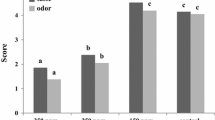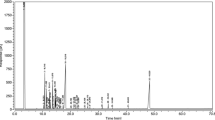Abstract
Essential oils (EOs) of coriander were analyzed by gas chromatography–mass spectrometry. Linalool (73.05 %), α-pinene (9.18 %), gamma-terpinene (7.65 %), geranyl acetate (2.71 %), were the main components of coriander essential oil. The minimum inhibitory concentration (MIC) of coriander was 2700 ppm in broth macrodilution. 3 × 105 CFU/g Byssochlamys fulva was inoculated in tomato sauce and different concentrations of EOs were added to each sample. Sodium benzoate at MIC concentration (250 ppm) was added to tomato sauce as a negative control. Samples were kept at 30 ± 0.5 °C for 2 months. The results showed that sodium benzoate completely stopped the fungi growth but 800 ppm coriander essential oils (CEO) and mixture of cinnamon (250 ppm) and coriander (800 ppm) essential oils inhibited up to 32 and 90 %, respectively.


Similar content being viewed by others
References
F. Kalantari, M. Barzegar, Z. Hamidi-Esfahani, Control of Aspergillus flavus growth in tomato paste by Cinnamomum zeylanicum and Origanum vulgare L. essential oils. World Acad. Sci. Eng. Technol. 66, 64–68 (2012)
J. Houbraken, R.A. Samson, J.C. Frisvad, Byssochlamys: significance of heat resistance and mycotoxin production. Adv. Exp. Med. Biol. 571, 211–224 (2006)
O. Puel, P. Galtier, I. Oswald, Biosynthesis and toxicological effects of patulin. Toxins 2, 613–631 (2010)
R.A. Samson, J. Houbraken, J. Varga, J.C. Frisvad, Polyphasic taxonomy of the heat resistant ascomycete genus Byssochlamys and its Paecilomyces anamorphs. Persoonia 22, 14–27 (2009)
J. Aliakbarlu, S. Sadaghiani, S. Mohammadi, Comparative evaluation of antioxidant and anti food-borne bacterial activities of essential oils from some spices commonly consumed in Iran. Food Sci. Biotechnol. 22, 1487–1493 (2013)
B. Teixeira, A. Marquesa, C. Ramosa, N.R. Neng, J.F.M. Nogueira, J.A. Saraiva, M.L. Nunes, Chemical composition and antibacterial and antioxidant properties of commercial essential oils. Ind. Crops Prod. 43, 587–595 (2013)
F. Silva, S. Ferreira, J.A. Queiroz, F.C. Domingues, Coriander (Coriandrum sativum L.) essential oil: its antibacterial activity and mode of action evaluated by flow cytometry. J. Med. Microbiol. 60, 1479–1486 (2011)
G.A. Burdock, I.G. Carabin, Safety assessment of coriander (Coriandrum sativum L.) essential oil as a food ingredient. Food Chem. Toxicol. 47, 22–34 (2009)
F. Darughe, M. Barzegar, M.A. Sahari, Antioxidant and antifungal activity of Coriander (Coriandrum sativum L.) essential oil in cake. Int. Food Res. J. 19, 1253–1260 (2012)
A.F. Begnamia, M.C.T. Daurteb, V. Furlettia, V.L.G. Rehde, Antimicrobial potential of Coriandrum sativum L. against different Candida species in vitro. Food Chem. 1, 74–77 (2010)
M. Michalczyk, R. Macura, I. Tesarowicz, J. Banaś, Effect of adding essential oils of coriander (Coriandrum sativum L.) and hyssop (Hyssopus officinalis L.) on the shelf life of ground beef. Meat Sci. 90, 824–850 (2012)
R.P. Adams, Identification of essential oil components by gas chromatography/mass spectrometry (Allured Publishing Corporation, Carol Stream, 2001)
F.W. McLafferty, D.B. Stauffer, The Wiley/Nbs registry of mass spectral data (Wiley, New York, 1989)
R. Fateh, M.J. Nasiri, M. Motevallian, M. Falahati, A. Yazdanparast, In vitro antifungal activity of Allium hirtifolium in comparison with the miconazole. Med. J. Islam. Republ. Iran 24, 17–22 (2010)
L.R. Beuchat, J.I. Pitt, Detection and enumerations of heat-resistant molds, pp. 217–222. In: Compendium of Methods for the Microbiological Examination of Foods. American Public Health Association, Washington DC (2001)
S.Y. Wang, S.T. Chang, Antifungal activity of essential oils and their constituents from ingenous Cinnamon (Cinnamomum Osmophloeum) leaves against wood decay fungi. Bioresour. Technol. 96, 813–818 (2005)
P.J. Delaquis, K. Stanich, B. Girard, G. Mazza, Antimicrobial activity of individual and mixed fractions of dill, cilantro, coriander and eucalyptus essential oils. Int. J. Food Microbiol. 74, 101–109 (2002)
P.R.S. Silva, I.C. Tessaro, L.D.F. Marczak, Integrating a kinetic microbial model with a heat transfer model to predict Byssochlamys fulva growth in refrigerated papaya pulp. J. Food Eng. 118, 279–288 (2013)
M.H.S. Sourmaghi, G. Kiaee, F. Golfakhrabadi, M. Khanavi, Comparison of essential oil composition and antimicrobial activity of Coriandrum sativum L. extracted by hydrodistillation and microwave-assisted hydrodistillation. J. Food Sci. Technol. (2014). doi:10.1007/s13197-014-1286-x
S. Zoubiri, A. Baaliouamer, Essential oil composition of Coriandrum sativum seed cultivated in Algeria as food grains protectant. Food Chem. 122, 1226–1228 (2010)
S. Yahya-abadi, A. Ziba-nejad, M. Doodi, Effect of some essential oils on growth of Aspergillus species. J. Herbal Drugs 2, 69–81 (2011)
V.C. Pawar, V.S. Thaker, In vitro efficacy of 75 essential oils against Aspergillus niger. Mycoses 49, 316–323 (2006)
G. Singh, S. Maurya, M.P. De Lampasona, C.A.N. Catalan, Studies on the essential oils, part 41. Chemical composition, antifungal, antioxidant and sprout suppressant activities of Coriander (Coriandrum sativum) essential oil and its oleoresin. Flavour Fragr. J. 21, 472–479 (2006)
H. Zardini, B. Tolueinia, Z. Tolueinia, Z. Hasani, M. Hasani, Analysis of antibacterial and antifungal activity of crude extracts from seeds of Coriandrum sativum. Gomal J. Med. Sci. 10, 167–171 (2012)
M. Lahlou, R. Berrada, Composition and niticidal activity of essential oils of three chemotypes of Rosmarinas officinalis L. Pharm. Biol. 141, 207–210 (2001)
N. Noori, F. Tooryan, N. Rokni, A. Akhondzadeh, A. Misaghi, Preservative effect of Cinnamomum Zeylanicum Blume. Essential oil and storage temperature on the growth of E. coli O157:H7 in hamburger using Hurdle Technology. JFST 7, 35–42 (2010)
S. Nanasombat, W. Pornpan, Antimicrobial and antioxidant activity of spice essential oils. Food Sci. Biotechnol. 20, 45–53 (2011)
J. Gutierrez, C. Barry-Ryan, P. Bourke, Antimicrobial activity of plant essential oils using food model media: efficacy, synergistic potential and interactions with food components. Food Microbiol. 26, 142–150 (2009)
N. Zamindar, S. Haraji, M. Doudi, Antifungal effect of cinnamon essential oil on Byssochlamys fulva in liquid medium and tomato sauce. Food Measure. (2015). doi:10.1007/s11694-015-9267-y
Author information
Authors and Affiliations
Corresponding author
Rights and permissions
About this article
Cite this article
Zamindar, N., Sadrarhami, M. & Doudi, M. Antifungal activity of coriander (Coriandrum sativum L.) essential oil in tomato sauce. Food Measure 10, 589–594 (2016). https://doi.org/10.1007/s11694-016-9341-0
Received:
Accepted:
Published:
Issue Date:
DOI: https://doi.org/10.1007/s11694-016-9341-0




